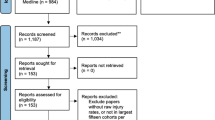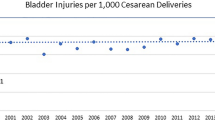Abstract
Objectives
The objective was to determine the prevalence of bladder injury during cesarean section (CS) and identify the risk factors causing these injuries, their management and the outcome.
Methods
We retrospectively reviewed the medical records of all the patients who had bladder injury during CS over a period of 25 years (1983–2007) at the King Fahad Hospital, Al-Khobar, Saudi Arabia. Demographic data, obstetric, surgical details, mechanism of injury, anatomic location, diagnosis, management and outcome were assessed.
Results
Thirty-four cases of bladder injury were identified among 7,708 cesarean deliveries performed during this period with an overall incidence of 0.44%. Primary CS was found in 41.2% of the patients and 58.8% had repeat CS giving an incidence of 0.27 and 0.81%, respectively. Bladder injury occurred when surgical difficulties were encountered during opening of the peritoneal cavity and while developing the bladder flap over the lower uterine segment, mainly due to adhesions and scar tissue resulting from previous abdominal surgery. All the bladder injuries were recognized intraoperatively and repaired with an overall satisfactory outcome. Repeat CS and presence of adhesions were found to be statistically significant risk factors in the study, while operator experience and emergency nature of the CS were considered risk factors in a few cases of bladder injury.
Conclusions
Data presented in this study indicates that bladder injury when adequately repaired is rarely associated with any complications. Multiple cesarean deliveries is a significant risk factor for bladder injury at the time of repeat CS and patients should be counseled regarding this risk before surgery.
Similar content being viewed by others
References
American College of Obstetricians and Gynecologists (2003) Surgery and patient choice: the ethics of decision making. ACOG Committee Opinion No. 289. Obstet Gynecol 102:1101–1106. doi:10.1016/j.obstetgynecol.2003.09.030
Buchholz NP, Daly-Grandeau E, Huber-Buchholz MM (1994) Urological complications associated with cesarean section. Eur J Obstet Gynecol Reprod Biol 56:161–163. doi:10.1016/0028-2243(94)90163-5
Davis JD (1999) Management of injuries to the urinary and gastrointestinal tract during cesarean section. Obstet Gynecol Clin North Am 26(3):469–480. doi:10.1016/S0889-8545(05)70091-7
Deneux-Tharaux C, Carmona E, Bouvier-Colle MH, Breart G (2006) Postpartum maternal mortality and cesarean delivery. Obstet Gynecol 108:541–548
Eisenkop SM, Richman R, Platt LD, Paul RH (1982) Urinary tract injury during cesarean section. Obstet Gynecol 60:591–596
Kaskarelis D, Sakkas J, Aravantinos D, Michalas S, Zolotas J (1975) Urinary tract injuries in gynecological and obstetrical procedures. Int Surg 60:40–43
Ludwig H, Loeffler FE (2001) Caesarean section on demand: an ethical dilemma. Arch Gynecol Obstet 264:169–170. doi:10.1007/s004040000145
Makoha FW, Felimban HM, Fathuddien MA, Ghabrah T (2004) Multiple cesarean section morbidity. Int J Gynaecol Obstet 87(3):227–232. doi:10.1016/j.ijgo.2004.08.016
Makoha FW, Tathuddien MA, Felimban HM (2005) Choice of abdominal incision and risk of trauma to the urinary bladder and bowel in multiple cesarean sections. Eur J Obstet Gynecol Reprod Biol 125:50–53. doi:10.1016/j.ejogrb.2005.06.017
Minkoff H, Chervenak FA (2003) Elective primary cesarean delivery. N Engl J Med 348:946–950. doi:10.1056/NEJMsb022734
Nielsen TF, Hokegard KH (1984) Cesarean section and intraoperative surgical complications. Acta Obstet Gynecol Scand 63:103–108
Onuora VC, al Ariyan R, Koko AH, Abdelwahab AS, al Jawini N (1997) Major injuries to the urinary tract in association with childbirth. East Afr Med J 74:523–526
Paterson-Brown S, Fisk NM (1997) Caesarean section: every woman’s right to choose? Curr Opin Obstet Gynecol 9:351–355. doi:10.1097/00001703-199712000-00003
Phillips M, Watabe B, Clemons JL, Weitzen S, Myers DL (2005) Risk factors for bladder injury during cesarean delivery. Obstet Gynecol 105:156–160
Rajasekar D, Hall M (1997) Urinary tract injuries during obstetric intervention. Br J Obstet Gynaecol 104:731–734
Yossepowitch O, Baniel J, Livine PM (2004) Urological injuries during cesarean section: intraoperative diagnosis and management. J Urol 172:196–199. doi:10.1097/01.ju.0000128632.29421.87
Conflicts of interest statement
None.
Author information
Authors and Affiliations
Corresponding author
Rights and permissions
About this article
Cite this article
Rahman, M.S., Gasem, T., Al Suleiman, S.A. et al. Bladder injuries during cesarean section in a University Hospital: a 25-year review. Arch Gynecol Obstet 279, 349–352 (2009). https://doi.org/10.1007/s00404-008-0733-1
Received:
Accepted:
Published:
Issue Date:
DOI: https://doi.org/10.1007/s00404-008-0733-1




